HRD Report: HR Development for Sun Court Residential Homes Limited
VerifiedAdded on 2020/02/05
|18
|5492
|95
Report
AI Summary
This report delves into the core aspects of Human Resource Development (HRD), focusing on learning styles, training needs analysis, and evaluation techniques within the context of Sun Court Residential Homes Limited. The report begins by exploring different learning styles, including the theories of Honey and Mumford, Kolb, and Myers-Briggs, and their implications for effective training program design. It then discusses the role of the learning curve and the importance of transferring learnings in the workplace. The report further examines the contribution of various learning theories, such as cognitive, reinforcement, and holistic theories, in planning and designing learning events. Moving on, the report addresses training needs at different staff levels, outlining the specific training requirements for management, customer service, and operational roles. It also presents a comparative analysis of various training methods, including performance appraisal, role-playing, discussions, induction, and workshops, highlighting their advantages and disadvantages. The report then proposes a systematic approach to training and development, including the preparation and evaluation of training programs using suitable techniques, and concludes with an examination of the role of government in training and development, the impact of competency development movements, and contemporary training initiatives, specifically in the UK context.
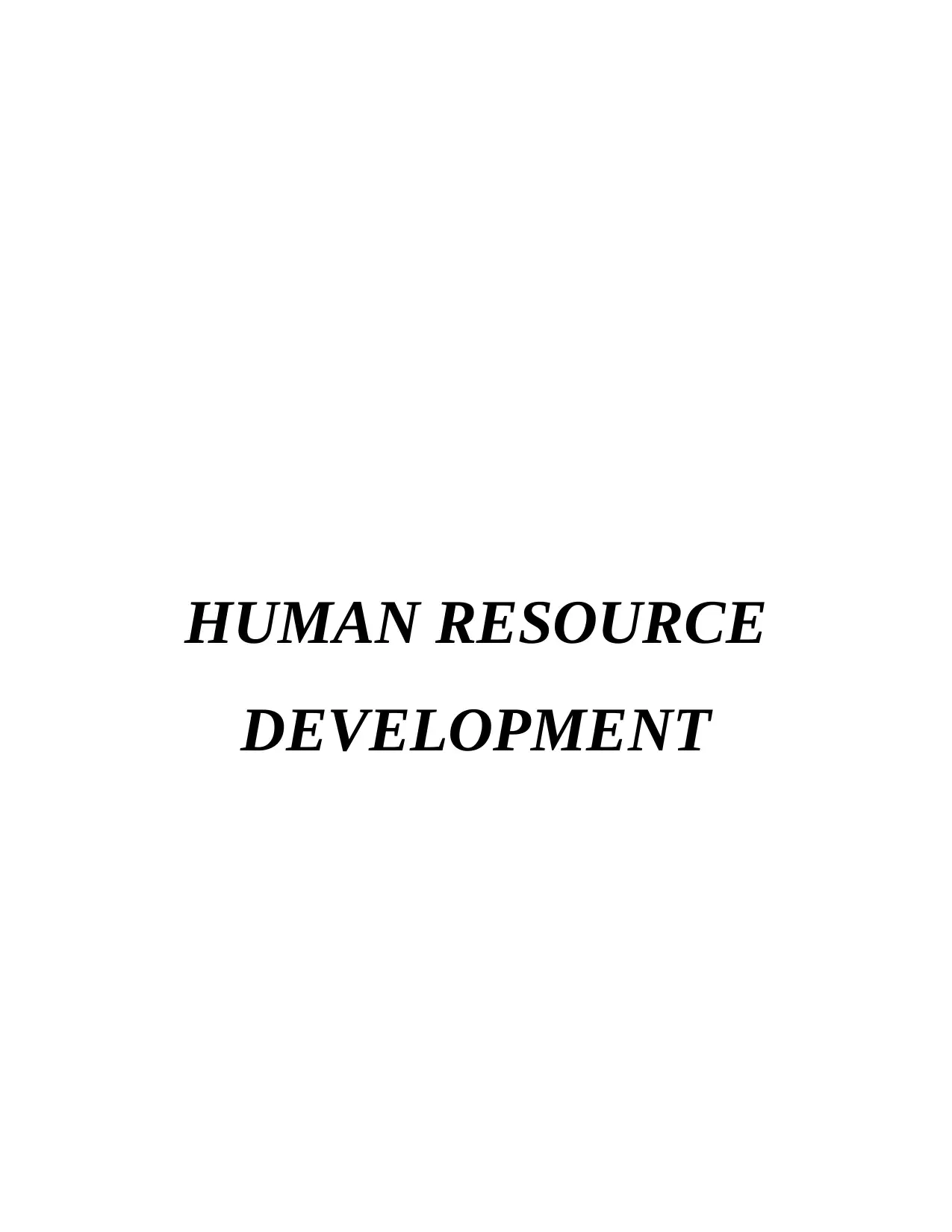
HUMAN RESOURCE
DEVELOPMENT
DEVELOPMENT
Paraphrase This Document
Need a fresh take? Get an instant paraphrase of this document with our AI Paraphraser
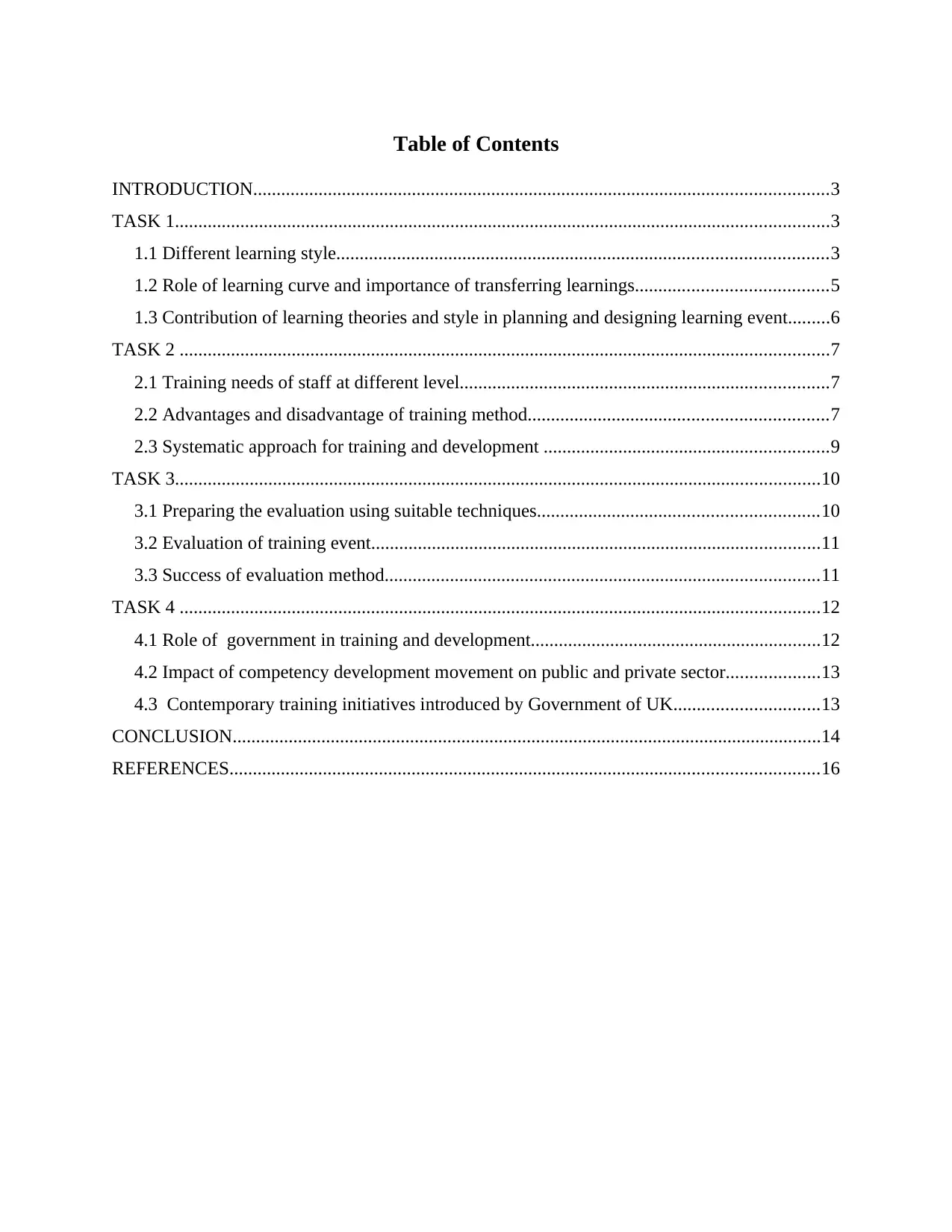
Table of Contents
INTRODUCTION...........................................................................................................................3
TASK 1............................................................................................................................................3
1.1 Different learning style.........................................................................................................3
1.2 Role of learning curve and importance of transferring learnings.........................................5
1.3 Contribution of learning theories and style in planning and designing learning event.........6
TASK 2 ...........................................................................................................................................7
2.1 Training needs of staff at different level...............................................................................7
2.2 Advantages and disadvantage of training method................................................................7
2.3 Systematic approach for training and development .............................................................9
TASK 3..........................................................................................................................................10
3.1 Preparing the evaluation using suitable techniques............................................................10
3.2 Evaluation of training event................................................................................................11
3.3 Success of evaluation method.............................................................................................11
TASK 4 .........................................................................................................................................12
4.1 Role of government in training and development..............................................................12
4.2 Impact of competency development movement on public and private sector....................13
4.3 Contemporary training initiatives introduced by Government of UK...............................13
CONCLUSION..............................................................................................................................14
REFERENCES..............................................................................................................................16
INTRODUCTION...........................................................................................................................3
TASK 1............................................................................................................................................3
1.1 Different learning style.........................................................................................................3
1.2 Role of learning curve and importance of transferring learnings.........................................5
1.3 Contribution of learning theories and style in planning and designing learning event.........6
TASK 2 ...........................................................................................................................................7
2.1 Training needs of staff at different level...............................................................................7
2.2 Advantages and disadvantage of training method................................................................7
2.3 Systematic approach for training and development .............................................................9
TASK 3..........................................................................................................................................10
3.1 Preparing the evaluation using suitable techniques............................................................10
3.2 Evaluation of training event................................................................................................11
3.3 Success of evaluation method.............................................................................................11
TASK 4 .........................................................................................................................................12
4.1 Role of government in training and development..............................................................12
4.2 Impact of competency development movement on public and private sector....................13
4.3 Contemporary training initiatives introduced by Government of UK...............................13
CONCLUSION..............................................................................................................................14
REFERENCES..............................................................................................................................16
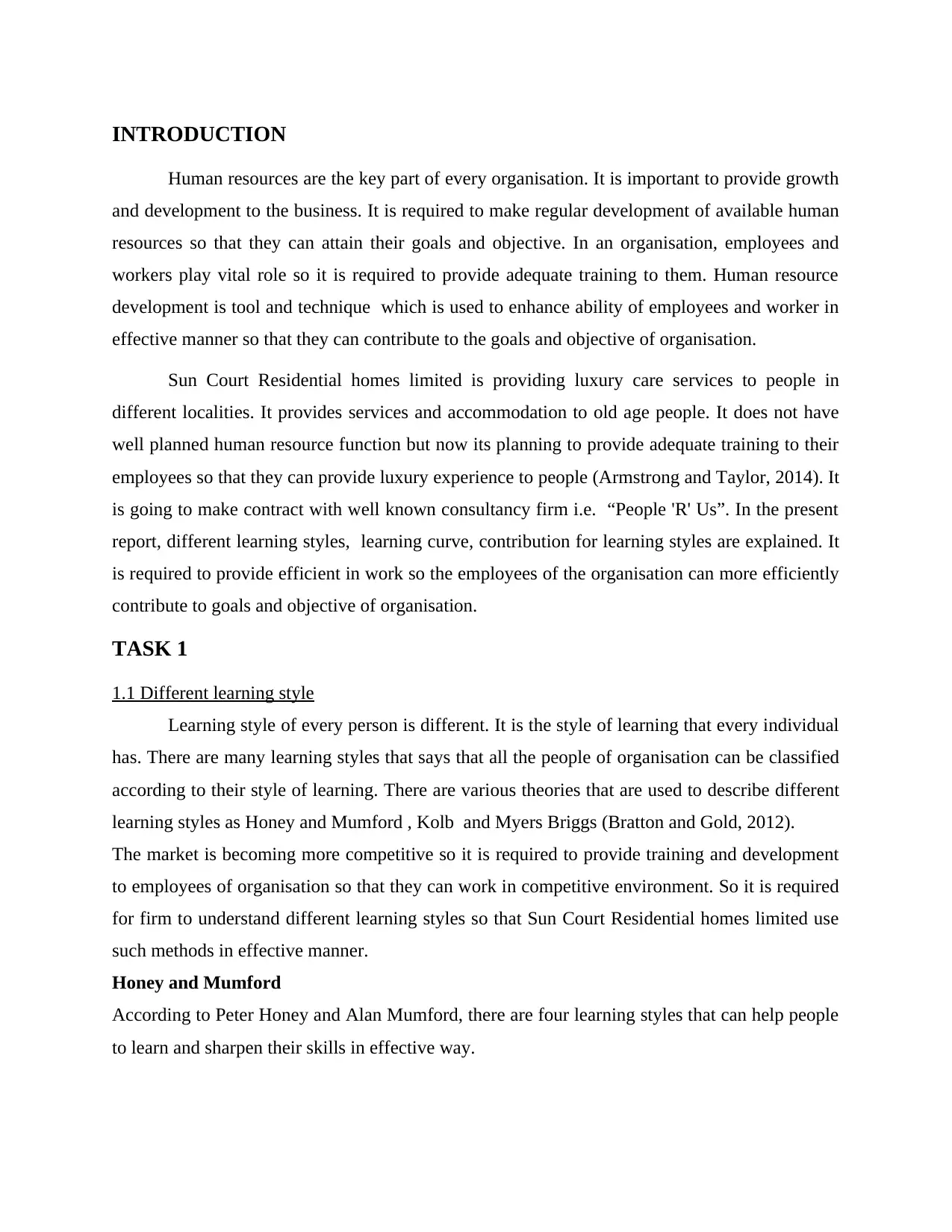
INTRODUCTION
Human resources are the key part of every organisation. It is important to provide growth
and development to the business. It is required to make regular development of available human
resources so that they can attain their goals and objective. In an organisation, employees and
workers play vital role so it is required to provide adequate training to them. Human resource
development is tool and technique which is used to enhance ability of employees and worker in
effective manner so that they can contribute to the goals and objective of organisation.
Sun Court Residential homes limited is providing luxury care services to people in
different localities. It provides services and accommodation to old age people. It does not have
well planned human resource function but now its planning to provide adequate training to their
employees so that they can provide luxury experience to people (Armstrong and Taylor, 2014). It
is going to make contract with well known consultancy firm i.e. “People 'R' Us”. In the present
report, different learning styles, learning curve, contribution for learning styles are explained. It
is required to provide efficient in work so the employees of the organisation can more efficiently
contribute to goals and objective of organisation.
TASK 1
1.1 Different learning style
Learning style of every person is different. It is the style of learning that every individual
has. There are many learning styles that says that all the people of organisation can be classified
according to their style of learning. There are various theories that are used to describe different
learning styles as Honey and Mumford , Kolb and Myers Briggs (Bratton and Gold, 2012).
The market is becoming more competitive so it is required to provide training and development
to employees of organisation so that they can work in competitive environment. So it is required
for firm to understand different learning styles so that Sun Court Residential homes limited use
such methods in effective manner.
Honey and Mumford
According to Peter Honey and Alan Mumford, there are four learning styles that can help people
to learn and sharpen their skills in effective way.
Human resources are the key part of every organisation. It is important to provide growth
and development to the business. It is required to make regular development of available human
resources so that they can attain their goals and objective. In an organisation, employees and
workers play vital role so it is required to provide adequate training to them. Human resource
development is tool and technique which is used to enhance ability of employees and worker in
effective manner so that they can contribute to the goals and objective of organisation.
Sun Court Residential homes limited is providing luxury care services to people in
different localities. It provides services and accommodation to old age people. It does not have
well planned human resource function but now its planning to provide adequate training to their
employees so that they can provide luxury experience to people (Armstrong and Taylor, 2014). It
is going to make contract with well known consultancy firm i.e. “People 'R' Us”. In the present
report, different learning styles, learning curve, contribution for learning styles are explained. It
is required to provide efficient in work so the employees of the organisation can more efficiently
contribute to goals and objective of organisation.
TASK 1
1.1 Different learning style
Learning style of every person is different. It is the style of learning that every individual
has. There are many learning styles that says that all the people of organisation can be classified
according to their style of learning. There are various theories that are used to describe different
learning styles as Honey and Mumford , Kolb and Myers Briggs (Bratton and Gold, 2012).
The market is becoming more competitive so it is required to provide training and development
to employees of organisation so that they can work in competitive environment. So it is required
for firm to understand different learning styles so that Sun Court Residential homes limited use
such methods in effective manner.
Honey and Mumford
According to Peter Honey and Alan Mumford, there are four learning styles that can help people
to learn and sharpen their skills in effective way.
⊘ This is a preview!⊘
Do you want full access?
Subscribe today to unlock all pages.

Trusted by 1+ million students worldwide

Following are the four learning styles as:-
1. The Activist: This learning style is related to those activist who learn by doings things.
They are very open minded people who like to learn by making group discussion and in
taking part in problem solving session (Boxall and Purcell, 2011). They are enthusiastic
toward new idea and things but they get bore with actual implementation in practical
sense. They are intended to work first and consider consequences of its last. Activists like
to work in team but they want to highlight themselves. They can change themselves from
one experience to another. Only one issue that arise is they don't want to work for long in
same area, they like to take different responsibility.
2. Reflectors: It is the learning style that is applied to those who like to stand back and
watch situation from different point of view and consider every aspect before coming to
conclusion and to take decision (Daley, 2012). They observe others before
implementation. They like to learn in situation where there is no tight deadlines. They
don't like to act as leader and role play in front of others.
3. Theorists: this style is applicable to those learner who like to consider the issue and
problem with step- by-step methodology. They are the people who like are more logical
and take decision after making proper study of theories and logical aspects. Their
decisions do not depend upon past learning and experience. They take decision by
making proper study of present situation.
Illustration 1: Honey and Mumford learning styles
1. The Activist: This learning style is related to those activist who learn by doings things.
They are very open minded people who like to learn by making group discussion and in
taking part in problem solving session (Boxall and Purcell, 2011). They are enthusiastic
toward new idea and things but they get bore with actual implementation in practical
sense. They are intended to work first and consider consequences of its last. Activists like
to work in team but they want to highlight themselves. They can change themselves from
one experience to another. Only one issue that arise is they don't want to work for long in
same area, they like to take different responsibility.
2. Reflectors: It is the learning style that is applied to those who like to stand back and
watch situation from different point of view and consider every aspect before coming to
conclusion and to take decision (Daley, 2012). They observe others before
implementation. They like to learn in situation where there is no tight deadlines. They
don't like to act as leader and role play in front of others.
3. Theorists: this style is applicable to those learner who like to consider the issue and
problem with step- by-step methodology. They are the people who like are more logical
and take decision after making proper study of theories and logical aspects. Their
decisions do not depend upon past learning and experience. They take decision by
making proper study of present situation.
Illustration 1: Honey and Mumford learning styles
Paraphrase This Document
Need a fresh take? Get an instant paraphrase of this document with our AI Paraphraser
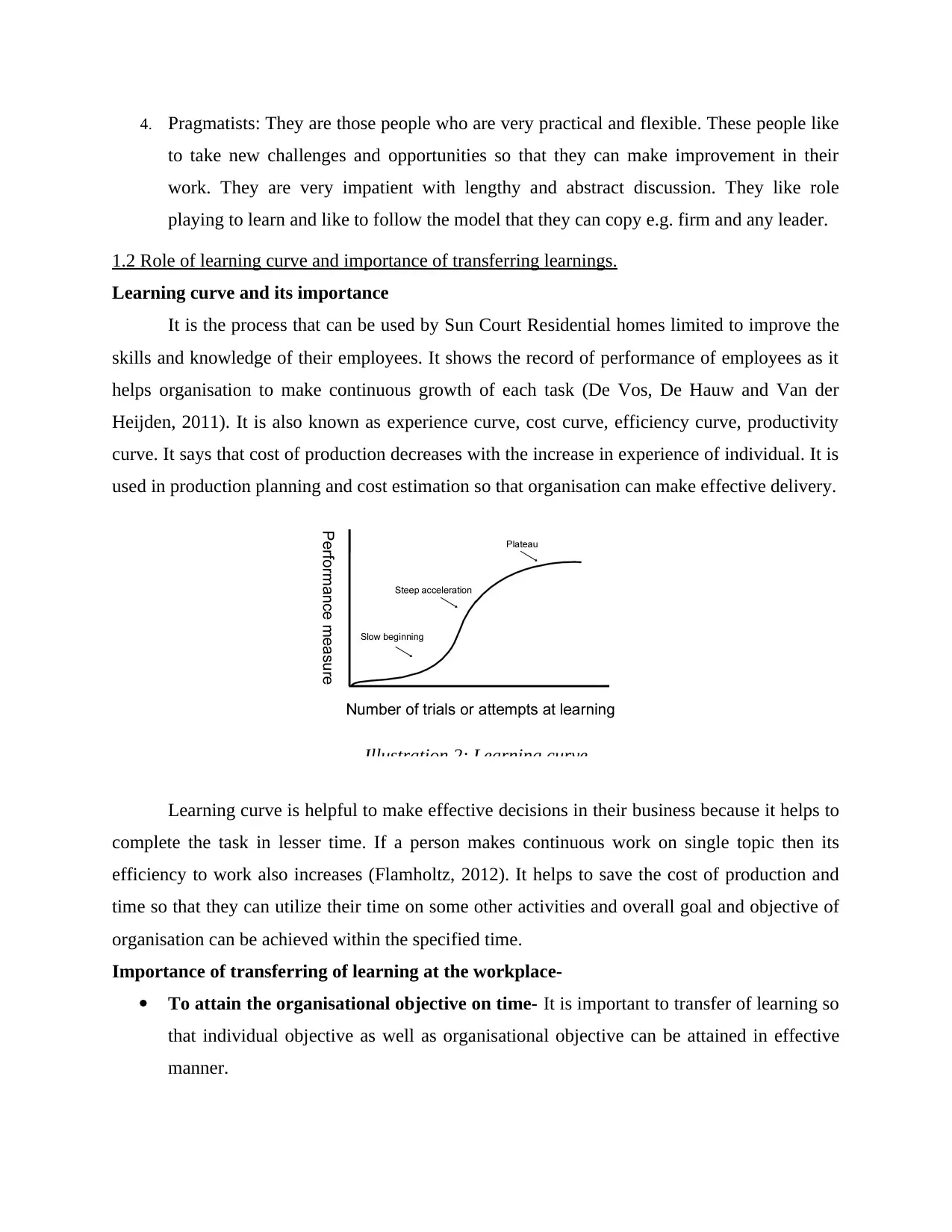
4. Pragmatists: They are those people who are very practical and flexible. These people like
to take new challenges and opportunities so that they can make improvement in their
work. They are very impatient with lengthy and abstract discussion. They like role
playing to learn and like to follow the model that they can copy e.g. firm and any leader.
1.2 Role of learning curve and importance of transferring learnings.
Learning curve and its importance
It is the process that can be used by Sun Court Residential homes limited to improve the
skills and knowledge of their employees. It shows the record of performance of employees as it
helps organisation to make continuous growth of each task (De Vos, De Hauw and Van der
Heijden, 2011). It is also known as experience curve, cost curve, efficiency curve, productivity
curve. It says that cost of production decreases with the increase in experience of individual. It is
used in production planning and cost estimation so that organisation can make effective delivery.
Learning curve is helpful to make effective decisions in their business because it helps to
complete the task in lesser time. If a person makes continuous work on single topic then its
efficiency to work also increases (Flamholtz, 2012). It helps to save the cost of production and
time so that they can utilize their time on some other activities and overall goal and objective of
organisation can be achieved within the specified time.
Importance of transferring of learning at the workplace-
To attain the organisational objective on time- It is important to transfer of learning so
that individual objective as well as organisational objective can be attained in effective
manner.
Illustration 2: Learning curve
to take new challenges and opportunities so that they can make improvement in their
work. They are very impatient with lengthy and abstract discussion. They like role
playing to learn and like to follow the model that they can copy e.g. firm and any leader.
1.2 Role of learning curve and importance of transferring learnings.
Learning curve and its importance
It is the process that can be used by Sun Court Residential homes limited to improve the
skills and knowledge of their employees. It shows the record of performance of employees as it
helps organisation to make continuous growth of each task (De Vos, De Hauw and Van der
Heijden, 2011). It is also known as experience curve, cost curve, efficiency curve, productivity
curve. It says that cost of production decreases with the increase in experience of individual. It is
used in production planning and cost estimation so that organisation can make effective delivery.
Learning curve is helpful to make effective decisions in their business because it helps to
complete the task in lesser time. If a person makes continuous work on single topic then its
efficiency to work also increases (Flamholtz, 2012). It helps to save the cost of production and
time so that they can utilize their time on some other activities and overall goal and objective of
organisation can be achieved within the specified time.
Importance of transferring of learning at the workplace-
To attain the organisational objective on time- It is important to transfer of learning so
that individual objective as well as organisational objective can be attained in effective
manner.
Illustration 2: Learning curve

Effective use of fund- When efficient people are working on task then it helps to reduce
the cost and expenses of organisation because a individual can perform various task.
Increase in productivity- It helps to increase productivity of organisation. When
efficient people are working in organisation then they will be able to complete more task
on given time period (Fowler, 2013).
Value addition: When organisation complete their task on time then it helps to build
image of organisation in market. It helps to increase the image and attract more people.
1.3 Contribution of learning theories and style in planning and designing learning event
Learning is change in behaviour for observable and internal activities. There are many
theories that can be used in this as Cognitive- Gestalt theory, Holistic learning theory, Kolb
theory, reinforcement theory. These theories are very helpful in designing learning activities and
programmes. Different people with different learning style can be motivated through different
strategies.
As per Sensory stimulation theory, effectiveness in the work can be made if there is use
of multiple senses. These simulation may be visual as facts, use of media, level of volume, other
techniques etc. As per reinforcement theory, there are positive and negative reinforcement. It
creates strengthen behaviour. Positive factors have impactful impact and it helps to motivate to
work (Gangani, McLean and Braden, 2006).
As per Holistic theory, human personality is of collection of emotion, imagination and
other factors also. These elements are for impactful learning. In Gestalt approach, sensibility of
learner is given more priority and learning process of each learner is designed according to their
needs.
Adult learning theory provides patter of learning for adult. It considers that adult brings
more experience of learning and trainer can utilize such in polishing their skills and knowledge.
It considers active participation of learner in planning and designing learning events.
From the analysis of above theories, it can be said that it is required for cited organisation
that different people requires different learning patter and these patters can be identified through
above theories. It helps in identifying their needs and make them efficient to perform well.
the cost and expenses of organisation because a individual can perform various task.
Increase in productivity- It helps to increase productivity of organisation. When
efficient people are working in organisation then they will be able to complete more task
on given time period (Fowler, 2013).
Value addition: When organisation complete their task on time then it helps to build
image of organisation in market. It helps to increase the image and attract more people.
1.3 Contribution of learning theories and style in planning and designing learning event
Learning is change in behaviour for observable and internal activities. There are many
theories that can be used in this as Cognitive- Gestalt theory, Holistic learning theory, Kolb
theory, reinforcement theory. These theories are very helpful in designing learning activities and
programmes. Different people with different learning style can be motivated through different
strategies.
As per Sensory stimulation theory, effectiveness in the work can be made if there is use
of multiple senses. These simulation may be visual as facts, use of media, level of volume, other
techniques etc. As per reinforcement theory, there are positive and negative reinforcement. It
creates strengthen behaviour. Positive factors have impactful impact and it helps to motivate to
work (Gangani, McLean and Braden, 2006).
As per Holistic theory, human personality is of collection of emotion, imagination and
other factors also. These elements are for impactful learning. In Gestalt approach, sensibility of
learner is given more priority and learning process of each learner is designed according to their
needs.
Adult learning theory provides patter of learning for adult. It considers that adult brings
more experience of learning and trainer can utilize such in polishing their skills and knowledge.
It considers active participation of learner in planning and designing learning events.
From the analysis of above theories, it can be said that it is required for cited organisation
that different people requires different learning patter and these patters can be identified through
above theories. It helps in identifying their needs and make them efficient to perform well.
⊘ This is a preview!⊘
Do you want full access?
Subscribe today to unlock all pages.

Trusted by 1+ million students worldwide

TASK 2
2.1 Training needs of staff at different level
Training is effective tool that is required to provide by Sun Court Residential homes
limited to their employees so that they can work more efficiently in their field. It is required to
hire skilled personal and to organise training programmes and session on regular basis for new
employees of organisation. It helps to increase the skills and knowledge of employees so that
they can work more efficiently in the organisation. It is helpful technique that is used by
organisation to achieve their goals and objective in efficient manner. There are different
techniques that can be adopted to provide training to different personal and to different level of
staff (Glover, Farris and Doolen, 2011).
To facilitate employees at different level and roles, it is required for cited organisation to
organisation training session and programmes for their employees so that they can work more
efficiently in effective manner.
Following are the training that is required to provide at different level:
Management level
(Top level)
Customers service level
(Middle level)
Operational level
(Lower level)
At this level, practical
knowledge is provided to
employees so that they can
build their skills, ability to
work in team and efficient
decision making.
It is required to provide
training so that they can
understand the circumstances
and it is also required for time
saving.
At this level, management
team review the methodology
of line managers. It is required
to motivate so that they can
perform their task in effective
manner.
Training programmes and
work shops are organised so
that skills can be enhanced.
Expert assistance is provided
so that they can more
efficiently work for customers
and client.
Cost minimization method is
used so that they can create
value in market.
2.1 Training needs of staff at different level
Training is effective tool that is required to provide by Sun Court Residential homes
limited to their employees so that they can work more efficiently in their field. It is required to
hire skilled personal and to organise training programmes and session on regular basis for new
employees of organisation. It helps to increase the skills and knowledge of employees so that
they can work more efficiently in the organisation. It is helpful technique that is used by
organisation to achieve their goals and objective in efficient manner. There are different
techniques that can be adopted to provide training to different personal and to different level of
staff (Glover, Farris and Doolen, 2011).
To facilitate employees at different level and roles, it is required for cited organisation to
organisation training session and programmes for their employees so that they can work more
efficiently in effective manner.
Following are the training that is required to provide at different level:
Management level
(Top level)
Customers service level
(Middle level)
Operational level
(Lower level)
At this level, practical
knowledge is provided to
employees so that they can
build their skills, ability to
work in team and efficient
decision making.
It is required to provide
training so that they can
understand the circumstances
and it is also required for time
saving.
At this level, management
team review the methodology
of line managers. It is required
to motivate so that they can
perform their task in effective
manner.
Training programmes and
work shops are organised so
that skills can be enhanced.
Expert assistance is provided
so that they can more
efficiently work for customers
and client.
Cost minimization method is
used so that they can create
value in market.
Paraphrase This Document
Need a fresh take? Get an instant paraphrase of this document with our AI Paraphraser
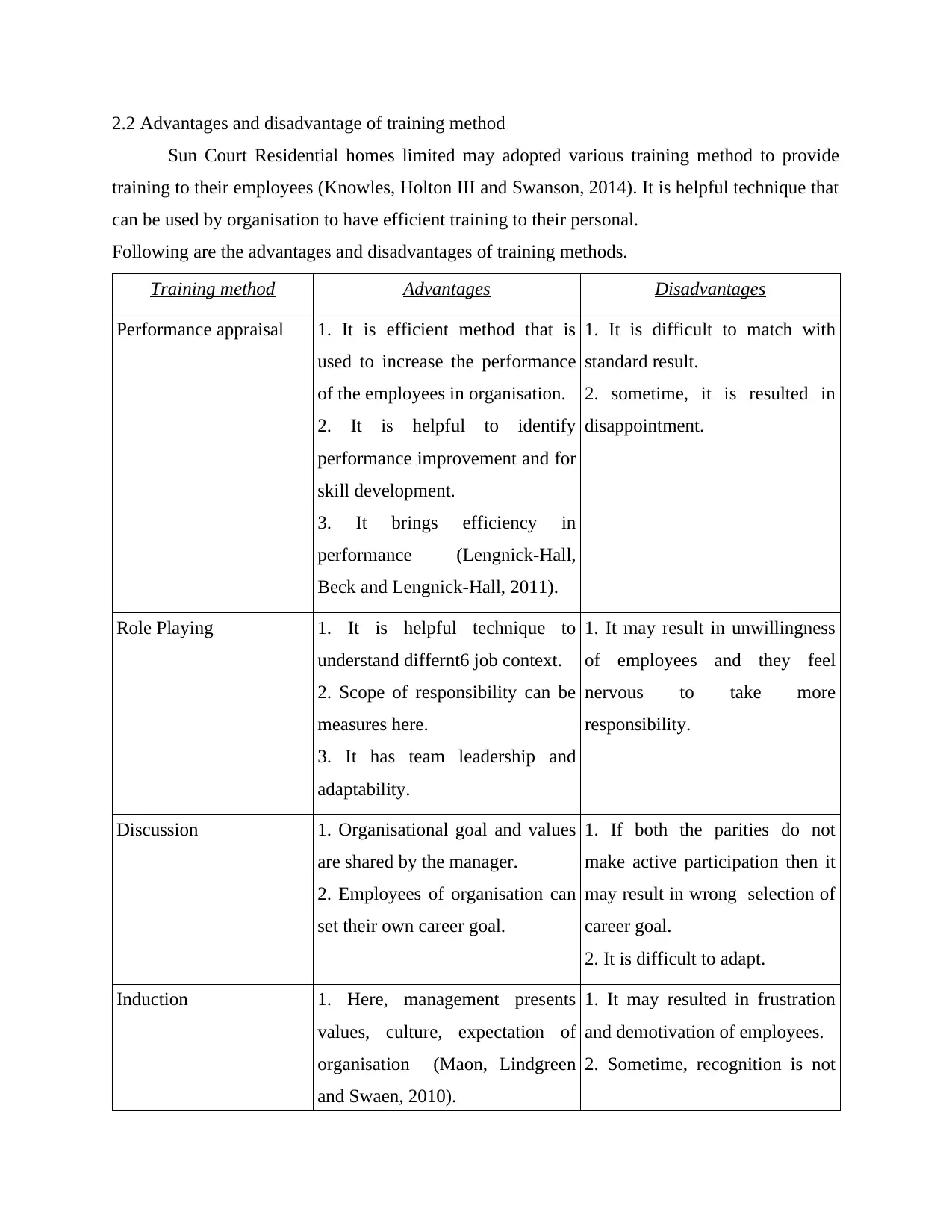
2.2 Advantages and disadvantage of training method
Sun Court Residential homes limited may adopted various training method to provide
training to their employees (Knowles, Holton III and Swanson, 2014). It is helpful technique that
can be used by organisation to have efficient training to their personal.
Following are the advantages and disadvantages of training methods.
Training method Advantages Disadvantages
Performance appraisal 1. It is efficient method that is
used to increase the performance
of the employees in organisation.
2. It is helpful to identify
performance improvement and for
skill development.
3. It brings efficiency in
performance (Lengnick-Hall,
Beck and Lengnick-Hall, 2011).
1. It is difficult to match with
standard result.
2. sometime, it is resulted in
disappointment.
Role Playing 1. It is helpful technique to
understand differnt6 job context.
2. Scope of responsibility can be
measures here.
3. It has team leadership and
adaptability.
1. It may result in unwillingness
of employees and they feel
nervous to take more
responsibility.
Discussion 1. Organisational goal and values
are shared by the manager.
2. Employees of organisation can
set their own career goal.
1. If both the parities do not
make active participation then it
may result in wrong selection of
career goal.
2. It is difficult to adapt.
Induction 1. Here, management presents
values, culture, expectation of
organisation (Maon, Lindgreen
and Swaen, 2010).
1. It may resulted in frustration
and demotivation of employees.
2. Sometime, recognition is not
Sun Court Residential homes limited may adopted various training method to provide
training to their employees (Knowles, Holton III and Swanson, 2014). It is helpful technique that
can be used by organisation to have efficient training to their personal.
Following are the advantages and disadvantages of training methods.
Training method Advantages Disadvantages
Performance appraisal 1. It is efficient method that is
used to increase the performance
of the employees in organisation.
2. It is helpful to identify
performance improvement and for
skill development.
3. It brings efficiency in
performance (Lengnick-Hall,
Beck and Lengnick-Hall, 2011).
1. It is difficult to match with
standard result.
2. sometime, it is resulted in
disappointment.
Role Playing 1. It is helpful technique to
understand differnt6 job context.
2. Scope of responsibility can be
measures here.
3. It has team leadership and
adaptability.
1. It may result in unwillingness
of employees and they feel
nervous to take more
responsibility.
Discussion 1. Organisational goal and values
are shared by the manager.
2. Employees of organisation can
set their own career goal.
1. If both the parities do not
make active participation then it
may result in wrong selection of
career goal.
2. It is difficult to adapt.
Induction 1. Here, management presents
values, culture, expectation of
organisation (Maon, Lindgreen
and Swaen, 2010).
1. It may resulted in frustration
and demotivation of employees.
2. Sometime, recognition is not
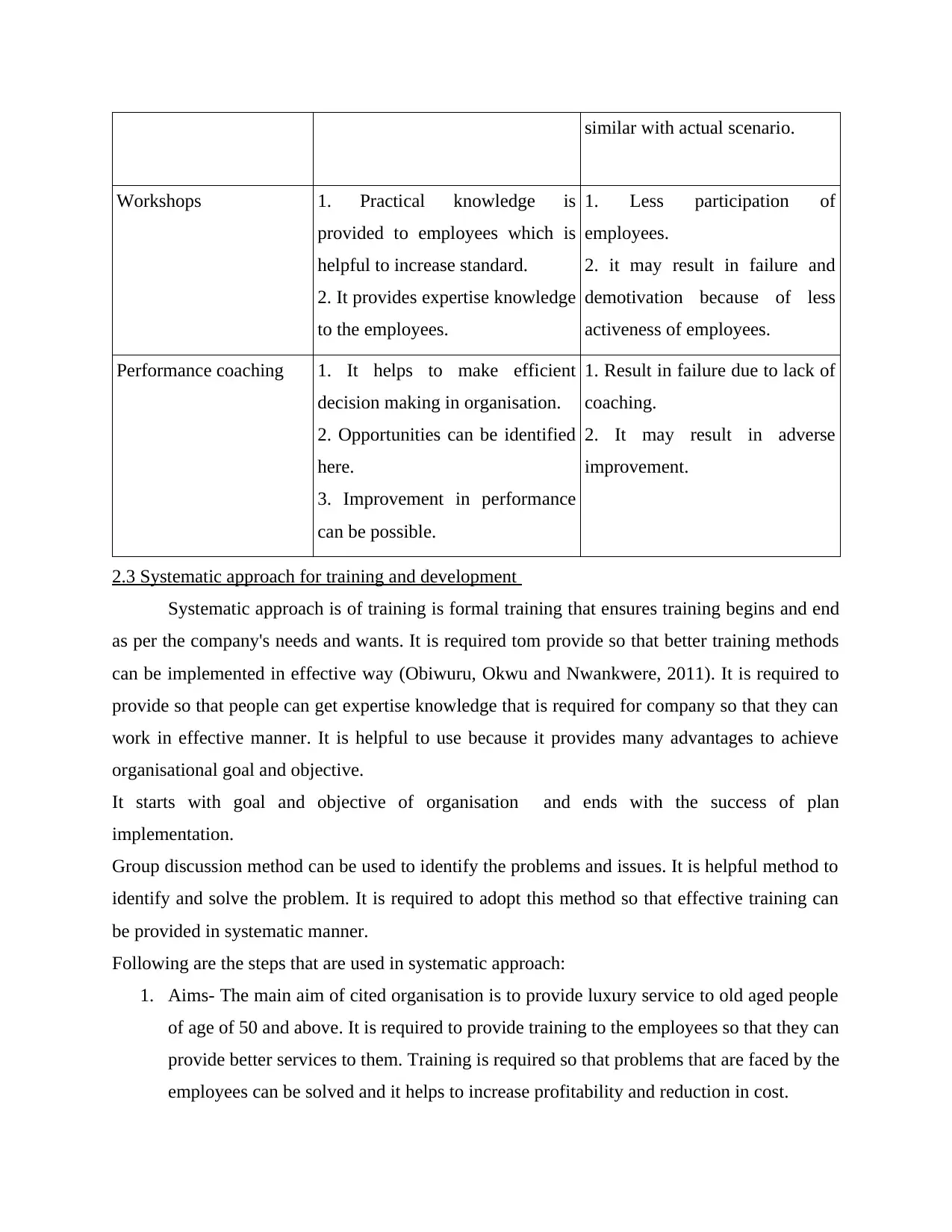
similar with actual scenario.
Workshops 1. Practical knowledge is
provided to employees which is
helpful to increase standard.
2. It provides expertise knowledge
to the employees.
1. Less participation of
employees.
2. it may result in failure and
demotivation because of less
activeness of employees.
Performance coaching 1. It helps to make efficient
decision making in organisation.
2. Opportunities can be identified
here.
3. Improvement in performance
can be possible.
1. Result in failure due to lack of
coaching.
2. It may result in adverse
improvement.
2.3 Systematic approach for training and development
Systematic approach is of training is formal training that ensures training begins and end
as per the company's needs and wants. It is required tom provide so that better training methods
can be implemented in effective way (Obiwuru, Okwu and Nwankwere, 2011). It is required to
provide so that people can get expertise knowledge that is required for company so that they can
work in effective manner. It is helpful to use because it provides many advantages to achieve
organisational goal and objective.
It starts with goal and objective of organisation and ends with the success of plan
implementation.
Group discussion method can be used to identify the problems and issues. It is helpful method to
identify and solve the problem. It is required to adopt this method so that effective training can
be provided in systematic manner.
Following are the steps that are used in systematic approach:
1. Aims- The main aim of cited organisation is to provide luxury service to old aged people
of age of 50 and above. It is required to provide training to the employees so that they can
provide better services to them. Training is required so that problems that are faced by the
employees can be solved and it helps to increase profitability and reduction in cost.
Workshops 1. Practical knowledge is
provided to employees which is
helpful to increase standard.
2. It provides expertise knowledge
to the employees.
1. Less participation of
employees.
2. it may result in failure and
demotivation because of less
activeness of employees.
Performance coaching 1. It helps to make efficient
decision making in organisation.
2. Opportunities can be identified
here.
3. Improvement in performance
can be possible.
1. Result in failure due to lack of
coaching.
2. It may result in adverse
improvement.
2.3 Systematic approach for training and development
Systematic approach is of training is formal training that ensures training begins and end
as per the company's needs and wants. It is required tom provide so that better training methods
can be implemented in effective way (Obiwuru, Okwu and Nwankwere, 2011). It is required to
provide so that people can get expertise knowledge that is required for company so that they can
work in effective manner. It is helpful to use because it provides many advantages to achieve
organisational goal and objective.
It starts with goal and objective of organisation and ends with the success of plan
implementation.
Group discussion method can be used to identify the problems and issues. It is helpful method to
identify and solve the problem. It is required to adopt this method so that effective training can
be provided in systematic manner.
Following are the steps that are used in systematic approach:
1. Aims- The main aim of cited organisation is to provide luxury service to old aged people
of age of 50 and above. It is required to provide training to the employees so that they can
provide better services to them. Training is required so that problems that are faced by the
employees can be solved and it helps to increase profitability and reduction in cost.
⊘ This is a preview!⊘
Do you want full access?
Subscribe today to unlock all pages.

Trusted by 1+ million students worldwide
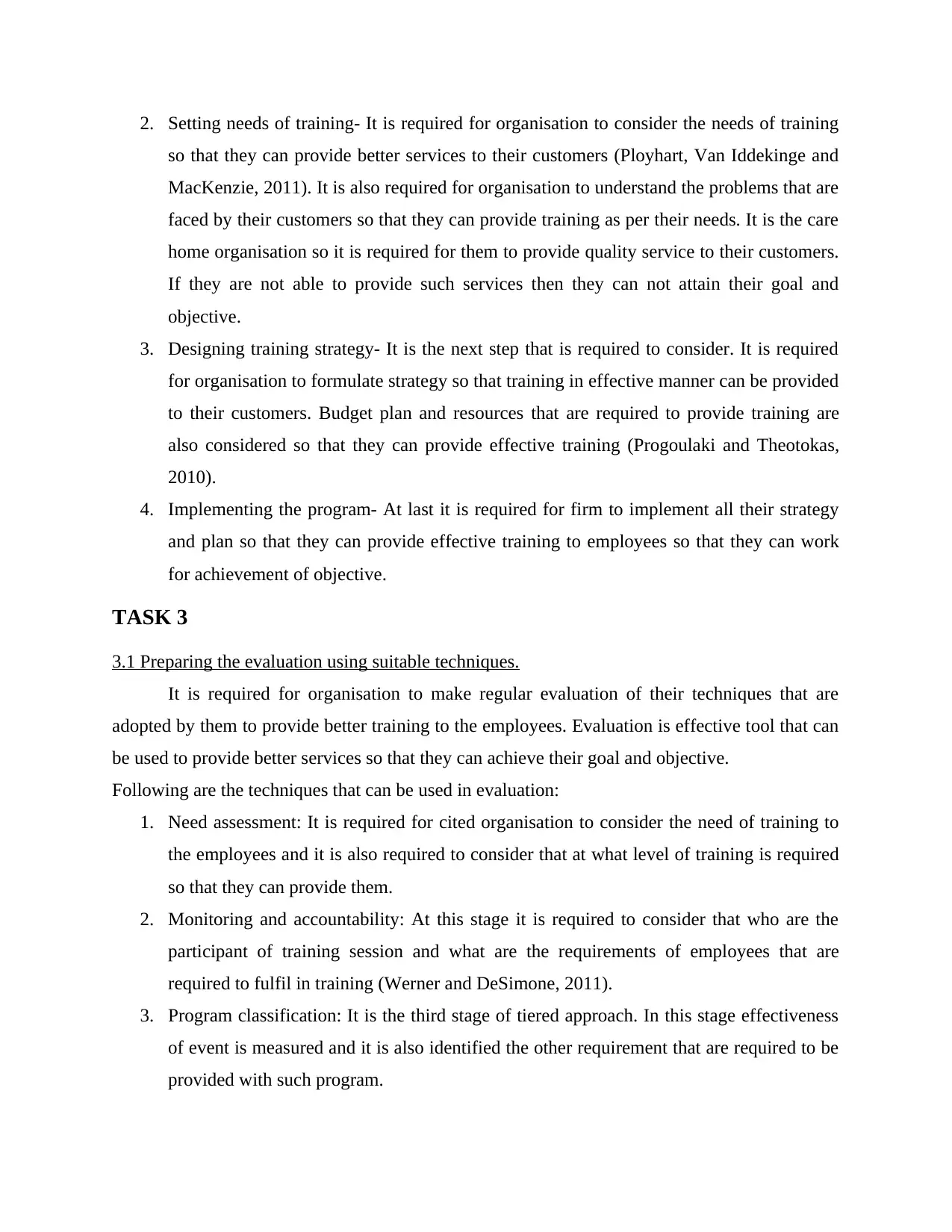
2. Setting needs of training- It is required for organisation to consider the needs of training
so that they can provide better services to their customers (Ployhart, Van Iddekinge and
MacKenzie, 2011). It is also required for organisation to understand the problems that are
faced by their customers so that they can provide training as per their needs. It is the care
home organisation so it is required for them to provide quality service to their customers.
If they are not able to provide such services then they can not attain their goal and
objective.
3. Designing training strategy- It is the next step that is required to consider. It is required
for organisation to formulate strategy so that training in effective manner can be provided
to their customers. Budget plan and resources that are required to provide training are
also considered so that they can provide effective training (Progoulaki and Theotokas,
2010).
4. Implementing the program- At last it is required for firm to implement all their strategy
and plan so that they can provide effective training to employees so that they can work
for achievement of objective.
TASK 3
3.1 Preparing the evaluation using suitable techniques.
It is required for organisation to make regular evaluation of their techniques that are
adopted by them to provide better training to the employees. Evaluation is effective tool that can
be used to provide better services so that they can achieve their goal and objective.
Following are the techniques that can be used in evaluation:
1. Need assessment: It is required for cited organisation to consider the need of training to
the employees and it is also required to consider that at what level of training is required
so that they can provide them.
2. Monitoring and accountability: At this stage it is required to consider that who are the
participant of training session and what are the requirements of employees that are
required to fulfil in training (Werner and DeSimone, 2011).
3. Program classification: It is the third stage of tiered approach. In this stage effectiveness
of event is measured and it is also identified the other requirement that are required to be
provided with such program.
so that they can provide better services to their customers (Ployhart, Van Iddekinge and
MacKenzie, 2011). It is also required for organisation to understand the problems that are
faced by their customers so that they can provide training as per their needs. It is the care
home organisation so it is required for them to provide quality service to their customers.
If they are not able to provide such services then they can not attain their goal and
objective.
3. Designing training strategy- It is the next step that is required to consider. It is required
for organisation to formulate strategy so that training in effective manner can be provided
to their customers. Budget plan and resources that are required to provide training are
also considered so that they can provide effective training (Progoulaki and Theotokas,
2010).
4. Implementing the program- At last it is required for firm to implement all their strategy
and plan so that they can provide effective training to employees so that they can work
for achievement of objective.
TASK 3
3.1 Preparing the evaluation using suitable techniques.
It is required for organisation to make regular evaluation of their techniques that are
adopted by them to provide better training to the employees. Evaluation is effective tool that can
be used to provide better services so that they can achieve their goal and objective.
Following are the techniques that can be used in evaluation:
1. Need assessment: It is required for cited organisation to consider the need of training to
the employees and it is also required to consider that at what level of training is required
so that they can provide them.
2. Monitoring and accountability: At this stage it is required to consider that who are the
participant of training session and what are the requirements of employees that are
required to fulfil in training (Werner and DeSimone, 2011).
3. Program classification: It is the third stage of tiered approach. In this stage effectiveness
of event is measured and it is also identified the other requirement that are required to be
provided with such program.
Paraphrase This Document
Need a fresh take? Get an instant paraphrase of this document with our AI Paraphraser
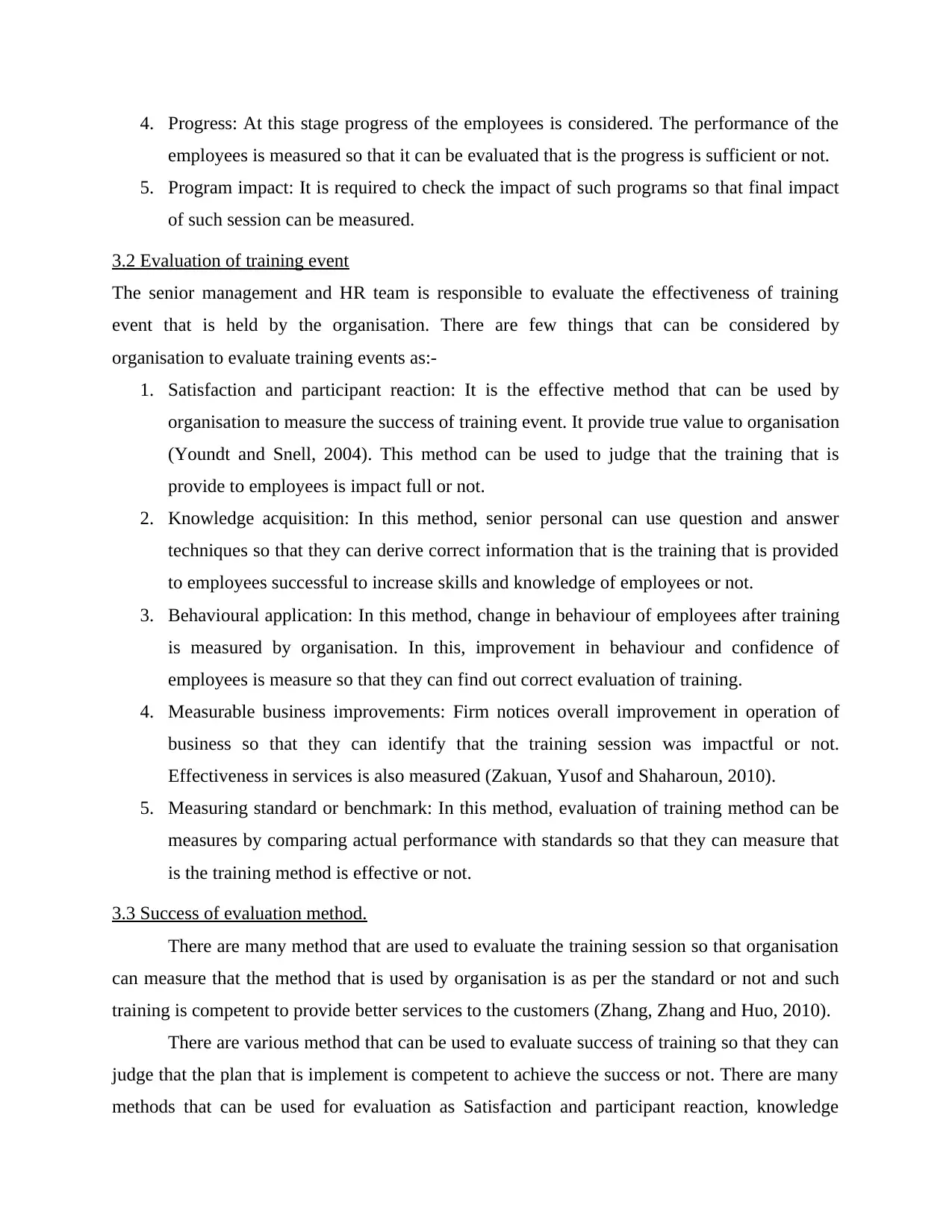
4. Progress: At this stage progress of the employees is considered. The performance of the
employees is measured so that it can be evaluated that is the progress is sufficient or not.
5. Program impact: It is required to check the impact of such programs so that final impact
of such session can be measured.
3.2 Evaluation of training event
The senior management and HR team is responsible to evaluate the effectiveness of training
event that is held by the organisation. There are few things that can be considered by
organisation to evaluate training events as:-
1. Satisfaction and participant reaction: It is the effective method that can be used by
organisation to measure the success of training event. It provide true value to organisation
(Youndt and Snell, 2004). This method can be used to judge that the training that is
provide to employees is impact full or not.
2. Knowledge acquisition: In this method, senior personal can use question and answer
techniques so that they can derive correct information that is the training that is provided
to employees successful to increase skills and knowledge of employees or not.
3. Behavioural application: In this method, change in behaviour of employees after training
is measured by organisation. In this, improvement in behaviour and confidence of
employees is measure so that they can find out correct evaluation of training.
4. Measurable business improvements: Firm notices overall improvement in operation of
business so that they can identify that the training session was impactful or not.
Effectiveness in services is also measured (Zakuan, Yusof and Shaharoun, 2010).
5. Measuring standard or benchmark: In this method, evaluation of training method can be
measures by comparing actual performance with standards so that they can measure that
is the training method is effective or not.
3.3 Success of evaluation method.
There are many method that are used to evaluate the training session so that organisation
can measure that the method that is used by organisation is as per the standard or not and such
training is competent to provide better services to the customers (Zhang, Zhang and Huo, 2010).
There are various method that can be used to evaluate success of training so that they can
judge that the plan that is implement is competent to achieve the success or not. There are many
methods that can be used for evaluation as Satisfaction and participant reaction, knowledge
employees is measured so that it can be evaluated that is the progress is sufficient or not.
5. Program impact: It is required to check the impact of such programs so that final impact
of such session can be measured.
3.2 Evaluation of training event
The senior management and HR team is responsible to evaluate the effectiveness of training
event that is held by the organisation. There are few things that can be considered by
organisation to evaluate training events as:-
1. Satisfaction and participant reaction: It is the effective method that can be used by
organisation to measure the success of training event. It provide true value to organisation
(Youndt and Snell, 2004). This method can be used to judge that the training that is
provide to employees is impact full or not.
2. Knowledge acquisition: In this method, senior personal can use question and answer
techniques so that they can derive correct information that is the training that is provided
to employees successful to increase skills and knowledge of employees or not.
3. Behavioural application: In this method, change in behaviour of employees after training
is measured by organisation. In this, improvement in behaviour and confidence of
employees is measure so that they can find out correct evaluation of training.
4. Measurable business improvements: Firm notices overall improvement in operation of
business so that they can identify that the training session was impactful or not.
Effectiveness in services is also measured (Zakuan, Yusof and Shaharoun, 2010).
5. Measuring standard or benchmark: In this method, evaluation of training method can be
measures by comparing actual performance with standards so that they can measure that
is the training method is effective or not.
3.3 Success of evaluation method.
There are many method that are used to evaluate the training session so that organisation
can measure that the method that is used by organisation is as per the standard or not and such
training is competent to provide better services to the customers (Zhang, Zhang and Huo, 2010).
There are various method that can be used to evaluate success of training so that they can
judge that the plan that is implement is competent to achieve the success or not. There are many
methods that can be used for evaluation as Satisfaction and participant reaction, knowledge

acquisition, behavioural application, measurable business improvements. These are the method
that provide correct picture of training session that are held by organisation for providing
training. Knowledge acquisition is one of the effective technique that can be adopted by
organisation to measure the correct picture of training session that are held by organisation. It is
required to adopt such methods so that employees of cited organisation can be trained in
effective manner and competent to provide luxury services to people who are associated with
Sun Court Residential homes limited (Armstrong and Taylor, 2014).
TASK 4
4.1 Role of government in training and development
Government is important part that helps to provide training and development
opportunities to the workers and employees. It is required to provide some assistance so that
people can provide efficiency in their services. It is important tool that provide assistance to
work more efficiently so that it may have quality in work. Government plays important role in
training and development programmes. There are many programmes held by the government in
which training to specific task is provided so that people can work with more efficiency (Boxall
and Purcell, 2011).
Following are the roles of government as:-
1. Generation of public norms: Government formulates various law and regulation that
imposed on organisation and it is required for organisation to follow such norms. It is
required for organisation to follow such norms and to provide training to personal so that
their worker can perform their task in effective manner.
2. Formulation of HR Policy: Government formulates HR policy that is required to follow
by all the companies that are in country. So it is the assistance that is provided to
employees of organisation. Training and development programmes are also part of HR
policy and it is required to be held by organisation so that their employees can be aware
of the working of organisation (Bratton and Gold, 2012).
3. Provide fund: There are many seminars that are held by the government in public. It
provides help to worker to work more efficiently. Government provides assistance by
way of funds to organisation so that they can implement such programmes in efficient
manner.
that provide correct picture of training session that are held by organisation for providing
training. Knowledge acquisition is one of the effective technique that can be adopted by
organisation to measure the correct picture of training session that are held by organisation. It is
required to adopt such methods so that employees of cited organisation can be trained in
effective manner and competent to provide luxury services to people who are associated with
Sun Court Residential homes limited (Armstrong and Taylor, 2014).
TASK 4
4.1 Role of government in training and development
Government is important part that helps to provide training and development
opportunities to the workers and employees. It is required to provide some assistance so that
people can provide efficiency in their services. It is important tool that provide assistance to
work more efficiently so that it may have quality in work. Government plays important role in
training and development programmes. There are many programmes held by the government in
which training to specific task is provided so that people can work with more efficiency (Boxall
and Purcell, 2011).
Following are the roles of government as:-
1. Generation of public norms: Government formulates various law and regulation that
imposed on organisation and it is required for organisation to follow such norms. It is
required for organisation to follow such norms and to provide training to personal so that
their worker can perform their task in effective manner.
2. Formulation of HR Policy: Government formulates HR policy that is required to follow
by all the companies that are in country. So it is the assistance that is provided to
employees of organisation. Training and development programmes are also part of HR
policy and it is required to be held by organisation so that their employees can be aware
of the working of organisation (Bratton and Gold, 2012).
3. Provide fund: There are many seminars that are held by the government in public. It
provides help to worker to work more efficiently. Government provides assistance by
way of funds to organisation so that they can implement such programmes in efficient
manner.
⊘ This is a preview!⊘
Do you want full access?
Subscribe today to unlock all pages.

Trusted by 1+ million students worldwide
1 out of 18
Related Documents
Your All-in-One AI-Powered Toolkit for Academic Success.
+13062052269
info@desklib.com
Available 24*7 on WhatsApp / Email
![[object Object]](/_next/static/media/star-bottom.7253800d.svg)
Unlock your academic potential
Copyright © 2020–2025 A2Z Services. All Rights Reserved. Developed and managed by ZUCOL.





